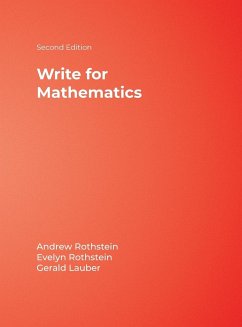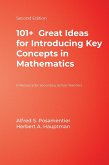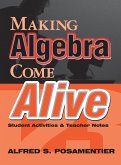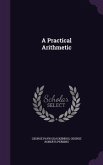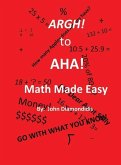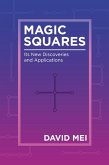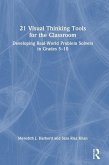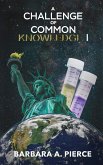- Gebundenes Buch
- Merkliste
- Auf die Merkliste
- Bewerten Bewerten
- Teilen
- Produkt teilen
- Produkterinnerung
- Produkterinnerung
Addressing NCTM standards, this second edition offers a wide range of practical writing strategies to help students deepen their understanding of mathematical concepts and theories.
Andere Kunden interessierten sich auch für
![101+ Great Ideas for Introducing Key Concepts in Mathematics 101+ Great Ideas for Introducing Key Concepts in Mathematics]() Alfred S. Posamentier101+ Great Ideas for Introducing Key Concepts in Mathematics80,99 €
Alfred S. Posamentier101+ Great Ideas for Introducing Key Concepts in Mathematics80,99 €![Making Algebra Come Alive Making Algebra Come Alive]() Alfred S. PosamentierMaking Algebra Come Alive71,99 €
Alfred S. PosamentierMaking Algebra Come Alive71,99 €![A Practical Arithmetic A Practical Arithmetic]() George Payn QuackenbosA Practical Arithmetic32,99 €
George Payn QuackenbosA Practical Arithmetic32,99 €![Argh! to AHA! Math Made Easy Argh! to AHA! Math Made Easy]() John DiamondidisArgh! to AHA! Math Made Easy20,99 €
John DiamondidisArgh! to AHA! Math Made Easy20,99 €![Magic Square Magic Square]() David MeiMagic Square9,99 €
David MeiMagic Square9,99 €![21 Visual Thinking Tools for the Classroom 21 Visual Thinking Tools for the Classroom]() Meredith J. Harbord21 Visual Thinking Tools for the Classroom168,99 €
Meredith J. Harbord21 Visual Thinking Tools for the Classroom168,99 €![A Challenge of Common Knowledge I A Challenge of Common Knowledge I]() Barbara A. PierceA Challenge of Common Knowledge I18,99 €
Barbara A. PierceA Challenge of Common Knowledge I18,99 €-
-
-
Addressing NCTM standards, this second edition offers a wide range of practical writing strategies to help students deepen their understanding of mathematical concepts and theories.
Produktdetails
- Produktdetails
- Verlag: Corwin
- 2. Auflage
- Seitenzahl: 296
- Erscheinungstermin: 24. August 2006
- Englisch
- Abmessung: 286mm x 221mm x 21mm
- Gewicht: 1010g
- ISBN-13: 9781412939935
- ISBN-10: 1412939933
- Artikelnr.: 21336862
- Herstellerkennzeichnung
- Libri GmbH
- Europaallee 1
- 36244 Bad Hersfeld
- gpsr@libri.de
- Verlag: Corwin
- 2. Auflage
- Seitenzahl: 296
- Erscheinungstermin: 24. August 2006
- Englisch
- Abmessung: 286mm x 221mm x 21mm
- Gewicht: 1010g
- ISBN-13: 9781412939935
- ISBN-10: 1412939933
- Artikelnr.: 21336862
- Herstellerkennzeichnung
- Libri GmbH
- Europaallee 1
- 36244 Bad Hersfeld
- gpsr@libri.de
Andrew S. Rothstein has had a distinguished career as a teacher, administrator, and researcher. His diverse and enriching experiences in international schools, special education, public schools, and consulting have given him a broad perspective of the contexts in which children learn. As an author and presenter, he has achieved wide acclaim for his work in improving school performance by focusing on improving instruction and its supervision. His work in integrating many subject areas through writing has been highly effective in improving test scores in districts across the country. As principal, Rothstein led site-based improvements that resulted in strong increases in student academic performance. While superintendent of a regional school serving children with severe physical disabilities and health impairments, Rothstein reorganized staff development, created new curricula, and integrated technology into the instructional program for children for children from prekindergarten through high school. He has been an adjunct professor at Southern Connecticut State University and Touro College. Rothstein earned a master¿s degree in special education from the University of North Carolina at Chapel Hill and a doctorate in educational administration from New York University.
Preface
Acknowledgments
About the Authors
1. Writing and Mathematics: An Introduction
2. Taxonomies: The Words and Symbols of Mathematics
3. Composing With Keywords: Mathematical Word Play
4. Metacognition for Mathematical Thinking
5. Defining Format for Mathematical Clarity
6. Morphology and Etymology for Expanding Mathematical Vocabulary
7. Profiles and Frames for Organizing Mathematical Information
8. Reasons, Procedures, and Results to Explain Mathematical Ideas and
Concepts
9. Who's Who in Mathematics for Biographies and Careers Related to
Mathematics
10. Where in the World for Relating Geography to Mathematics
11. Personifications and Interactions for Knowledge and Humor
12. Mathematically Literate: Knowing, Applying, and Communicating
Mathematics
Resource A: Rubrics for Writing for Mathematics
Resource B: Reproducible Templates for Students
Bibliography
Index
Acknowledgments
About the Authors
1. Writing and Mathematics: An Introduction
2. Taxonomies: The Words and Symbols of Mathematics
3. Composing With Keywords: Mathematical Word Play
4. Metacognition for Mathematical Thinking
5. Defining Format for Mathematical Clarity
6. Morphology and Etymology for Expanding Mathematical Vocabulary
7. Profiles and Frames for Organizing Mathematical Information
8. Reasons, Procedures, and Results to Explain Mathematical Ideas and
Concepts
9. Who's Who in Mathematics for Biographies and Careers Related to
Mathematics
10. Where in the World for Relating Geography to Mathematics
11. Personifications and Interactions for Knowledge and Humor
12. Mathematically Literate: Knowing, Applying, and Communicating
Mathematics
Resource A: Rubrics for Writing for Mathematics
Resource B: Reproducible Templates for Students
Bibliography
Index
Preface
Acknowledgments
About the Authors
1. Writing and Mathematics: An Introduction
2. Taxonomies: The Words and Symbols of Mathematics
3. Composing With Keywords: Mathematical Word Play
4. Metacognition for Mathematical Thinking
5. Defining Format for Mathematical Clarity
6. Morphology and Etymology for Expanding Mathematical Vocabulary
7. Profiles and Frames for Organizing Mathematical Information
8. Reasons, Procedures, and Results to Explain Mathematical Ideas and
Concepts
9. Who's Who in Mathematics for Biographies and Careers Related to
Mathematics
10. Where in the World for Relating Geography to Mathematics
11. Personifications and Interactions for Knowledge and Humor
12. Mathematically Literate: Knowing, Applying, and Communicating
Mathematics
Resource A: Rubrics for Writing for Mathematics
Resource B: Reproducible Templates for Students
Bibliography
Index
Acknowledgments
About the Authors
1. Writing and Mathematics: An Introduction
2. Taxonomies: The Words and Symbols of Mathematics
3. Composing With Keywords: Mathematical Word Play
4. Metacognition for Mathematical Thinking
5. Defining Format for Mathematical Clarity
6. Morphology and Etymology for Expanding Mathematical Vocabulary
7. Profiles and Frames for Organizing Mathematical Information
8. Reasons, Procedures, and Results to Explain Mathematical Ideas and
Concepts
9. Who's Who in Mathematics for Biographies and Careers Related to
Mathematics
10. Where in the World for Relating Geography to Mathematics
11. Personifications and Interactions for Knowledge and Humor
12. Mathematically Literate: Knowing, Applying, and Communicating
Mathematics
Resource A: Rubrics for Writing for Mathematics
Resource B: Reproducible Templates for Students
Bibliography
Index

